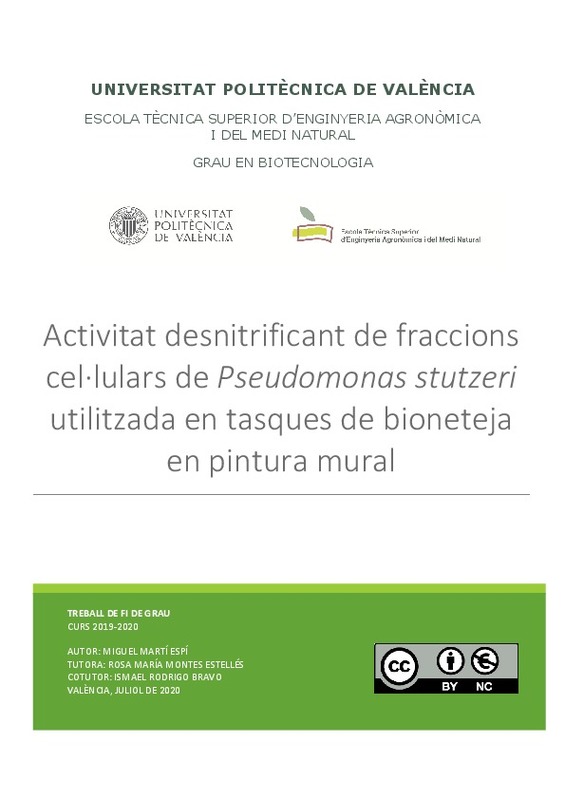|
Resumen:
|
[CA] En els últims anys, s'ha investigat i treballat a la utilització d'aplicacions biotecnològiques per a la restauració d'obres d'art, particularment en la neteja de pintures murals amb l'aplicació d'aquests bacteris ...[+]
[CA] En els últims anys, s'ha investigat i treballat a la utilització d'aplicacions biotecnològiques per a la restauració d'obres d'art, particularment en la neteja de pintures murals amb l'aplicació d'aquests bacteris vius, el que s'ha denominat bioneteja en els treballs de conservació de pintura mural.
En el Laboratori de Microbiologia de la UPV s'ha desenvolupat aquesta tècnica i s'ha aplicat a les pintures murals de les esglésies de Sant Nicolau i dels Sants Joans de València, utilitzant Pseudomonas stutzeri per a l'eliminació de crostes de nitrats insolubles, obtenint-se resultats espectaculars.
No obstant això, l'ús de bacteris vius limita molt la tècnica i els treballs en els quals es pot aplicar, per tant, es considera interessant investigar si és possible utilitzar els bacteris inactius o una fracció d'ells i que es conserve l'activitat desnitrificant.
Una vegada identificada la capacitat desnitrificant del cep aïllat, que implica un primer pas de reducció de nitrat a nitrit mitjançant l'acció de una nitrat reductasa, es procedeix a la identificació i caracterització d'aquesta activitat enzimàtica.
Per a això, s'estudia la possibilitat de realitzar extractes enzimàtics a partir dels cultius bacterians, estudiant l'efectivitat de diferents mètodes de disrupció cel·lular descrits a la bibliografia (ruptura per ultrasons, ús de detergents, ús de cicles de congelació/descongelació) amb l'objectiu d'obtenir un lisat cel·lular que continga l'activitat nitrat reductasa.
S'investiga la compartimentalització de la dita activitat mitjançant fraccionament subcel·lular utilitzant diferents estratègies. Del lisat total (TL) s'obtindrà la fracció periplasmàtica i citosòlica (CPP) i la fracció membranosa total (TM), la qual pot dividir-se en les seues corresponents fraccions de membrana externa i interna.
A més a més, s'investiga bibliogràficament la possibilitat que aquesta activitat siga part del proteoma periplasmàtic, estudiant la preparació selectiva de proteïnes periplasmàtiques mitjançant diferents procediments, que deixarien les proteïnes periplasmàtiques en la fracció sobrenedant després d'una centrifugació.
Amb les dades obtingudes en bibliografia, es valorarà la possibilitat d'obtenir una preparació purificada de l'activitat nitrat reductasa de Pseudomonas stutzeri que constitueixi el punt de partida d'una aplicació biotecnològica per a l'eliminació de crostes de nitrats en processos de restauració d'obres d'art.
[-]
[EN] At the last years, biotechnology applications have been researched and worked on the restoration of artworks, particularly at the clean-up of mural paintings, with the aplication of these alive bacteria, this technique ...[+]
[EN] At the last years, biotechnology applications have been researched and worked on the restoration of artworks, particularly at the clean-up of mural paintings, with the aplication of these alive bacteria, this technique has been named biocleaning.
In the Laboratory of Microbiology of the UPV, this technology has been developed and applied at the mural paintings of the churches of Sant Nicolau and Sants Joans of València, using Pseudomonas stutzeri for the deletion of crusts of insoluble nitrates, obtaining spectacular results.
Nevertheless, the use of alive bacteria limits a lot the technique and the works at which can apply, therefore, the use of dormant bacteria or a fraction of them that conserve the denitrifying activity is interesting.
When the denitrifying capacity of the isolated strain is identificated, that implies a first step where nitrate becomes nitrite by the act of the nitrate reductase, the next step is the identification and characterization of this enzymatic activity.
For this, the possibility to realise enzymatic extracts from the bacterial crops has been studied, studying the effectiveness of distinct methods of cellular disruption described at the bibliography (rupture for ultrasounds, use of detergents, use of cycles of freezing/thawing) with the aim to obtain a cellular lysate that contain the nitrate reductase activity.
The compartmentalization of the denitrifying activity by subcellular fractionation using different strategies has been researched. The periplasmic and cytosolic fraction (CPP) and the total membranous fraction (TM), which can divide at his corresponding fractions of external and internal membrane it will obtain, has been obtained of the total lysate (TL).
In addition, the possibility that this activity was part of the periplasmic proteome has been researches bibliographically, studying the selective readiness of periplasmic proteins by distinct procedures, staying the periplasmic proteins at the supernatant fraction after a centrifugation.
With the data obtained in the bibliography, the possibility of obtaining a purified preparation of the nitrate reductase activity of Pseudomonas stutzeri, which constitutes the starting point of a biotechnological application for the removal of nitrate crusts in restoration processes of works of art, will be evaluated.
[-]
|







